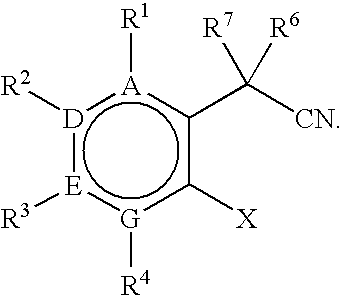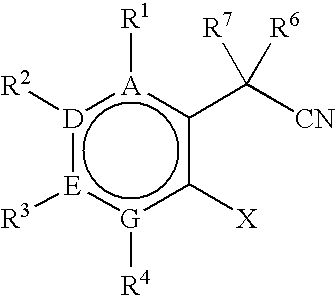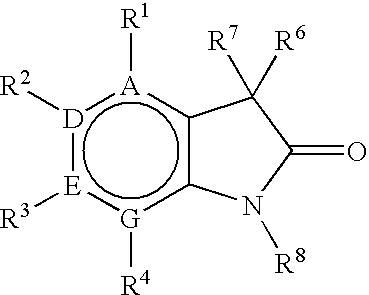Process for preparing 3,3-disubstituted oxindoles and thio-oxindoles
a technology of oxindole and thio-oxindole, which is applied in the field of preparing oxindole and thio-oxindole compounds, can solve the problems of low yield of products
- Summary
- Abstract
- Description
- Claims
- Application Information
AI Technical Summary
Benefits of technology
Problems solved by technology
Method used
Image
Examples
example 1
Product distribution in the reaction of 1,2,3-trifluorobenzene and 2-methylpropionitrile in the presence of various bases.
[0093] The reaction tubes of Mettler Toledo MiniBlock™ were independently charged with 1,2,3-trifluorobenzene (1.32 g, 0.01 mol). A solution of 2-methylpropionitrile (14 g) in toluene (160 mL) was prepared and 8.5 mL (containing 0.01 mol of 2-methylpropionitrile) was dispensed to each tube. Equimolar amounts of the bases in Table 1 were then added dropwise at ambient temperature. The mixtures were heated to 65° C. over 3 hours, cooled to ambient temperature and quenched with 5% hydrochloric acid (6 mL each). The organic phases were separated and solvents evaporated. The residues were analyzed by GC / MS as solutions in acetonitrile.
TABLE 1Normalized (area %) product distribution2-[3-(Cyano-dimethyl-2-(2,3-Difluorophenyl)-2-(2,6-Difluorophenyl)-methyl)-2-fluorophenyl]-Conc. (M) / 2-methylpropionitrile2-methylpropionitrile2-methylpropionitrileBaseSolvent(Isomer A)(...
example 2
Product distribution in the reaction of 1,2,3-trifluorobenzene and 2-methylpropionitrile in the presence of isopropylmagnesium chloride in various solvents.
[0095] This example was performed as described in Example 1, whereby seven samples were prepared by dissolving 1,2,3-trifluorobenzene (1.32 g, 0.01 mol) and 2-methylpropionitrile (0.9 mL, 0.69 g, 0.01 mol) in the solvent (8 mL each) noted in Table 2. Isopropylmagnesium chloride (2M in THF, 5 mL each) was independently added dropwise to these mixtures. The mixtures were then heated to 35° C. over 3 hours, cooled to ambient temperature and quenched with 5% HCl (6 mL). The reaction mixture containing triethylamine was additionally treated with concentrated hydrochloric acid. The organic phases were separated and the solvents were evaporated. The residues were analyzed by GC / MS as solutions in acetonitrile.
TABLE 2Normalized (area %) product distributionSolventIsomer AIsomer BIsomer CTetrahydrofuran83.016.50.4Dioxane83.716.301,2-D...
example 3
Product distribution in the reaction of 1,2,3-trifluorobenzene and 2-methylpropionitrile in the presence of isopropylmagnesium chloride at various temperatures.
[0097] Three flasks were equipped with a thermocouple, condenser with a nitrogen inlet, and a magnetic stirring bar. 1,2,3-trifluorobenzene (1.32 g, 0.01 mol) and 2-methylpropionitrile (0.9 mL, 0.69 g, 0.01 mol) were added to each flask and thereby dissolved in THF (8 mL). The contents of the first flask were cooled to −25° C.; the contents of the second flask were cooled to 0° C.; and the contents of the third flask were heated to 60° C. Isopropylmagnesium chloride (2M in THF, 5 mL each) was added dropwise to each solution maintaining the respective reaction temperatures. After 2 hours, the reactions were quenched with 5% HCl (6 mL each). The organic phases were separated and the solvent was evaporated. The residues were analyzed by GC / MS as solutions in acetonitrile. See, Table 3.
TABLE 3Normalized (area %) product distr...
PUM
| Property | Measurement | Unit |
|---|---|---|
| temperature | aaaaa | aaaaa |
| temperature | aaaaa | aaaaa |
| temperature | aaaaa | aaaaa |
Abstract
Description
Claims
Application Information
 Login to View More
Login to View More - R&D
- Intellectual Property
- Life Sciences
- Materials
- Tech Scout
- Unparalleled Data Quality
- Higher Quality Content
- 60% Fewer Hallucinations
Browse by: Latest US Patents, China's latest patents, Technical Efficacy Thesaurus, Application Domain, Technology Topic, Popular Technical Reports.
© 2025 PatSnap. All rights reserved.Legal|Privacy policy|Modern Slavery Act Transparency Statement|Sitemap|About US| Contact US: help@patsnap.com



